 |
| Mountains in Alaska (above) |
The first one I thought of was: mountains. And, starting simple, mountain ranges. Here's the idea: a life list of mountain ranges. See them all!
North America has three major mountain ranges running down the east, center, and west of the continent. I grew up in New York and Ohio and lived in New Jersey and Pennsylvania when I was very small, so I've seen a lot of the Appalachians. They are a grand mountain range, but old, having once been as least as tall as the Rockies (see article). Today the highest peak is 6,684 feet. From a geology point of view, they are a lesson in mountain aging. Aesthetically, though, they are gorgeous and full of breath- taking hikes without having to gasp for air.
 |
| An Appalachian overlook, from a trip in 1969 |
The Rockies are just west of the center of North America, stretching from New Mexico to the Arctic Circle. They frequently reach 14,000 feet but, while they are still rising slightly, slowly, they are probably about as high as they are going to get, because of erosion countering the gradual rise. They are rugged and spectacular, with national parks and forests throughout, with lots of places to camp and hike.
(In normal times. As I write this the border with Canada is closed due to the covid-19 pandemic and Rocky Mountain National Park and the national forests in northern Colorado are closed due to forest fires, the fires still burning despite snow and cold weather. This post is about future adventures!)
Rocky Mountains in Colorado, seen from a view point at 11,000'.
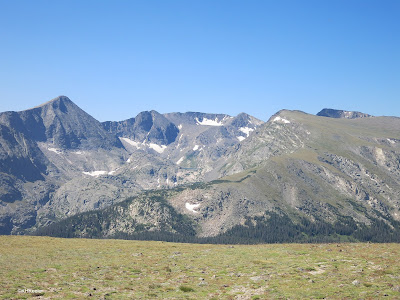 |
| Rocky Mountains seen from the top of Trail Ridge Road in Colorado's Rocky Mountain National Park |
On the far west of North America, two mountain ranges, the Sierra Nevadas and the Cascades, run north from southern California to southern British Columbia. The Alaska Range encompasses several small mountain ranges (of massive mountains) in western Alaska. These far western mountain ranges, with the highest North American peaks, including Mt. Whitney in California at 14,505 feet, Mt. St. Elias in Canada's Yukon Territory at 19,541', and Denali in Alaska at 20,310' are still growing. Frequent earthquakes and volcanic eruptions are part of that, as the Pacific continental plate pushes eastward, forcing the Juan de Fuca Plate, the Gorda Plate and other small techtonic plates under the North American Plate (link). They form a complex and spectacular group of mountain ranges, full of wonderful places to explore. The photo below, of Yosemite National Park, is from 1970, when I was a graduate student in California. With friends, I backpacked into some truly memorable places.
 |
| Yosemite National Park scene, 1970 |
Collecting mountain ranges, one should include a stop in Central America to see the mountains that run down the center of the region. They are low by North American standards, although the tallest is over 13,000', but active, all rising as plates under the Atlantic, Pacific, and South America collide. They are also critically important in blocking flow of tropical plants and animals between the Atlantic to Pacific Coasts. The two coastal regions, although close together today, have long separate histories.
 |
| mountains of central Costa Rica |
In South America, the Andes, running down the western side of the contient, is a very young mountain range and still rising. Its highest peak, Mt. Aconcagua in Argentina, is over 22,000'. My picture of the Andes was taken on the Altiplano of Chile, a plain at an average elevation 12,300', looking west to much higher peaks. I wanted, flying east out of Lima, Peru over the Andes, to take a photo from the plane but cloud cover totally obscured the view.
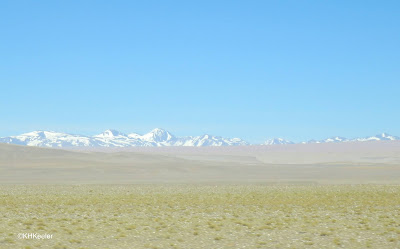 |
| Andes from the Altiplano in Chile |
 |
| the Pyrenees from Montserrat, Spain |
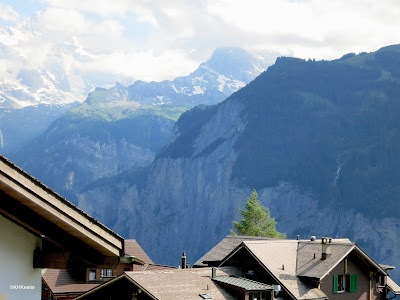 |
| the Alps from Wengen, Switzerland |
There are several mountain ranges in central Asia that I know nothing about, but the Himalayas, the largest, highest range in the world, dominate all tales of this world's mountains. They lie north of India, east of China, have many of the world's tallest mountains, including of course Mt. Everest, and are still going up as the techtonic plate that is the subcontinent of India drives north in to Asia. I have only seen the eastern edge of the Himalayas, from Lijiang in western China. Someday...
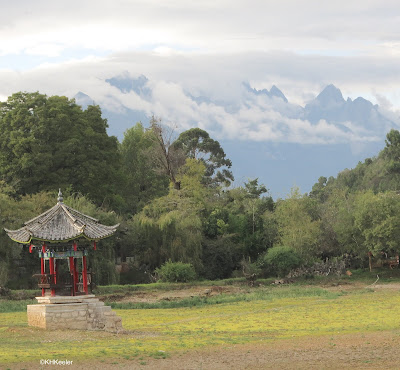 |
| 18,000' mountain above Lijiang, China, eastern edge of the Himalayas |
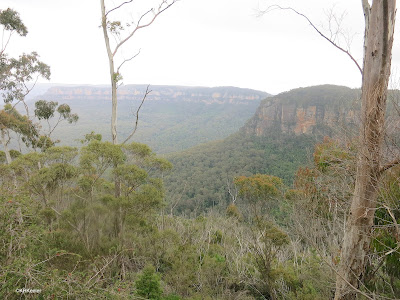 |
| Blue Mountains, Australia |
Writing this post showed me how little I know of the world's mountains, and how many I have yet to see. Viewing mountains, I noticed their height and learned about their age. Old mountains are generally eroded, low and rounded, while young mountains, still going up, are active, with volcanoes and earthquakes, and sharp, steep slopes. I recognize many plant species and high elevations in distant areas can share species. When they are too distant to have the same plants, often high elevations select for similiar plant adapations, so very different plants look quite similar at first glance: succulent rosette forms in the alpine tundra, for example. But there is much more one could take in while visiting mountains, in particular differences in geology.
Mountains and mountain ranges are beautiful and photogenic, interesting and complex. When going internationally isn't an option, one can work on the life list within the United States. The Blue Ridge Mountains and the Tetons are recognized ranges that, above, I lumped in the Appalachians and Rockies, respectively. And there are more.
 |
| Wyoming landscape Wikipedia says there are 109 named mountain ranges in Wyoming alone! |
Comments and corrections welcome.
Kathy Keeler, A Wandering Botanist
More at awanderingbotanist.com
Join me on Facebook: https://www.facebook.com/AWanderingBotanist
what a fabulous post! Since moving to Spain, I have become enamoured with mountains, their geology, flora and fauna. I have not even scratched the surface of what there is to know, but it gives me inspiration to know that in spite of our current pandemic crisis, I live in a valley surrounded by mountains and can explore these new (to me), worlds from my back door. Thank you again for this beautifully written entry.
ReplyDeleteI like mountains and traveling too... so its quite amazing to read this type of informative stuff. So my advice to all the people to read this amazing post to get information about different mountains.
ReplyDeletekailash parvat facts
Wow now I am know there are so many beaches in India with the help of your blogs so thanks to sharing this information with us and please also write on this topic because I love mountains to and there are so many kailash parvat facts
ReplyDeleteThis comment has been removed by the author.
ReplyDeleteAlaska is wonderful place to spend holidays and this is the best place to see northern lights.
ReplyDeletebest time to go to alaska
Trip to see the northern lights
This is really cool and love to be here.
ReplyDeleteHope you will find an amazing thing on your travel to Dubai.
With the best amenities and the cheap place to stay with extra safety. First central hotel with a complete city guide support at all the time.
Space with adventure
ReplyDeleteA Wandering Botanist great information you have share so you know about Longest Mountain Range in The World
ReplyDeleteThe Culinary Historians of Southern California's website often showcases recent presentations, typically posted shortly afterward. While I can't confirm the online availability of Gold's presentation, there have been some notable recent ones that are certainly worth exploring. lava lounge houston
ReplyDelete